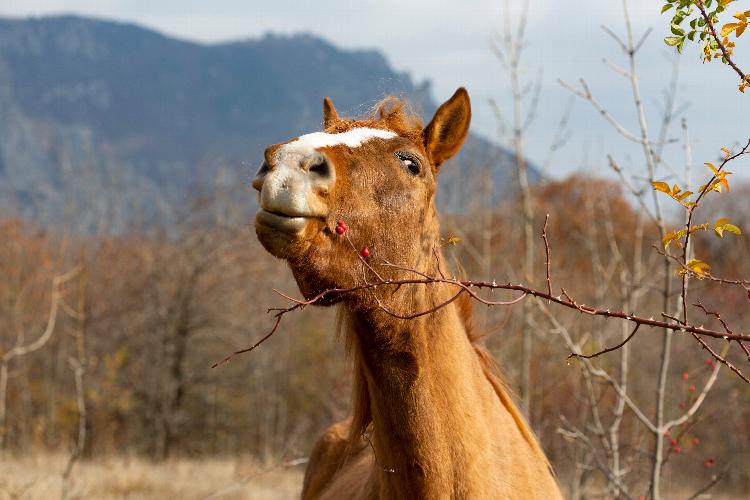WHAT I S ANIMAL SELF- HEALING?
Animal self-healing, also known as "Zoopharmacognosy", is a remarkable behavioural science. It demonstrates how wild, free-roaming animals instinctively seek out, select, and utilize natural healing sources in their environment. This behaviour is a result of evolution, which has shaped both animals and plants to interact to their mutual benefit. Animals, with their highly developed senses, can perceive what may be helpful to them. This innate knowledge, honed through evolution, and their exceptional sensory perception, allows them to not only meet their food requirements but also their medicinal needs, maintaining and restoring their health and balance.
Even domesticated animals and livestock have exceptional senses well beyond those of humans, and they can instinctively identify remedies that will benefit them.
 It was initially observed in certain chimpanzee populations where certain leaves or pith were being eaten with obvious unwillingness. It soon became apparent that this reluctant leaf swallowing had its foundation in self-medication (self-healing behaviour). Why would an animal eat something that certainly gave him no enjoyment and offered no nutritional value? What, then, were the possibilities and implications for helping animals rediscover this instinct and heal themselves?
It was initially observed in certain chimpanzee populations where certain leaves or pith were being eaten with obvious unwillingness. It soon became apparent that this reluctant leaf swallowing had its foundation in self-medication (self-healing behaviour). Why would an animal eat something that certainly gave him no enjoyment and offered no nutritional value? What, then, were the possibilities and implications for helping animals rediscover this instinct and heal themselves?
 (Photo left) Cat sniffs and munches on fresh Catnip, thought to promote "feel good" pheromones. Cats will often back roll on the plant or dried herb which also has insect repellent properties and now being researched as a mosquito repellent.
(Photo left) Cat sniffs and munches on fresh Catnip, thought to promote "feel good" pheromones. Cats will often back roll on the plant or dried herb which also has insect repellent properties and now being researched as a mosquito repellent.
Wild, free-roaming animals have evolved and developed a strong recognition and relate and communicate with their natural environment in a variety of ways to maintain their life force and survival. They interpret their territory as sights, sounds, smells, tastes and emotions. These highly developed senses are essential evolutionary equipment that is crucial, not only for their own survival but also for the survival of the species. This sensory perception enables them to extract from their environment not just their food requirements but also the medicinal requirements needed to maintain their own health. The process by which animals self-medicate, using aromatic medicinal plants – some toxic, along with soils, clays and charcoal to treat and prevent diseases and illness is zoopharmacognosy or simply put, animal self-healing behaviour.
In our self-appointed role as keepers and protectors of animals, it's natural that we want to do our very best to ensure that animals under our care are safe, happy and healthy. We need to be able to offer them the ability to utilise their environment as they would in the wild. Whether it's our pets at home, the livestock on our farms or the vulnerable animals in zoos, shelters and wildlife sanctuaries around the world, caring for animals is a natural human instinct and responsibility.
Many terrestrial animals, particularly herbivores, rely on plants for their nutritional and metabolic needs. These are the primary metabolites—the providers of their basic nutritional needs: carbohydrates, fats, and proteins. What many of us are unaware of is that they also rely on non-nutritional secondary metabolites from medicinal plants to maintain or restore their health and avert disease or illness.
 (Photo left) Wild and free-roaming horses eat rosehips, which are rich in vitamin C, to help strengthen their immune systems before winter.
(Photo left) Wild and free-roaming horses eat rosehips, which are rich in vitamin C, to help strengthen their immune systems before winter.
Natural Remedies & Plant Secondary Metabolites?
One of the theories behind this self-healing behaviour is centred on plant secondary metabolites, organic compounds which aren't essential to primary functions such as growth and reproduction but are essential for the long-term health and well-being of an animal. Unlike primary metabolites, certain secondary metabolites are often not necessary in a healthy animal and are only required to fight off infection, disease or parasites.

(Photo on left) Wild Macaws on clay lick as a source of minerals to supplement their diet and to promote the elimination of intestinal parasites.
Secondary metabolites are a plant's natural protection agents and are unique to medicinal plants. Plants produce secondary metabolites as defences against unfavourable weather conditions such as drought, fungi, bacteria, insects and viruses. They also produce them as colourful pigments to attract insects for pollination. Secondary metabolites occur naturally in an animal's environment and have no nutritional value. Animals ingest them or use them instinctively – only if their body has a need. They are often bitter when eaten and so are usually only taken in small amounts by wild animals.
The vast majority of human and animal pharmaceuticals today are derived from plant material secondary metabolites. Secondary metabolites themselves are produced by plants in order to protect themselves from such dangers as drought, bacteria, insects and viruses. Of course, plants often rely on animals to thrive, such as bees spreading pollen, so it should come as no surprise that in the interests of symbiosis these healing properties are able to be utilised by animals as well.
Book a discovery call to see how I can help your animal 0753 993 0835
#animaltherapy #animalselfhealing #aromatherapy #animalhealth #animalbehaviour
Copyright ©wildsense.co.uk

